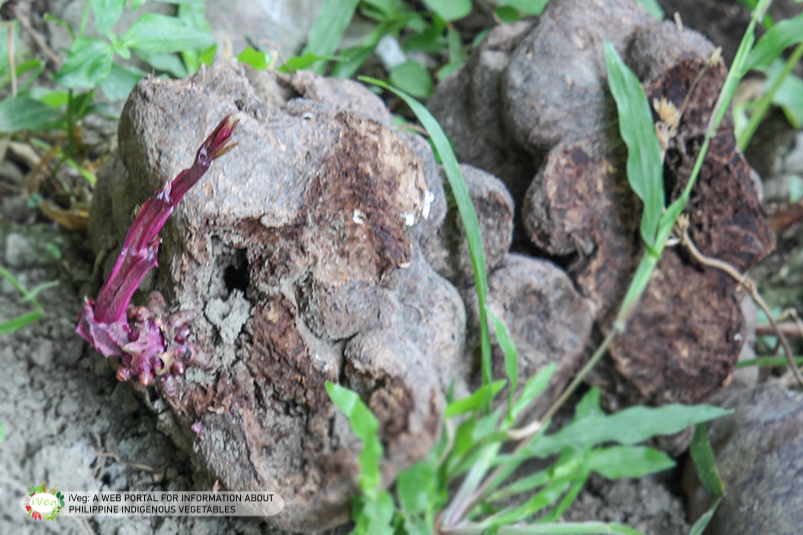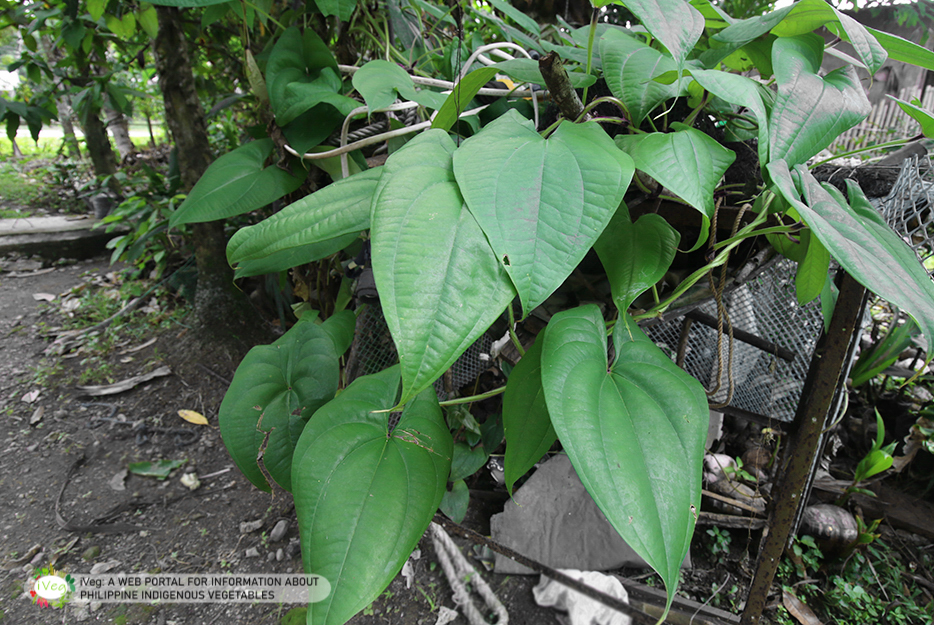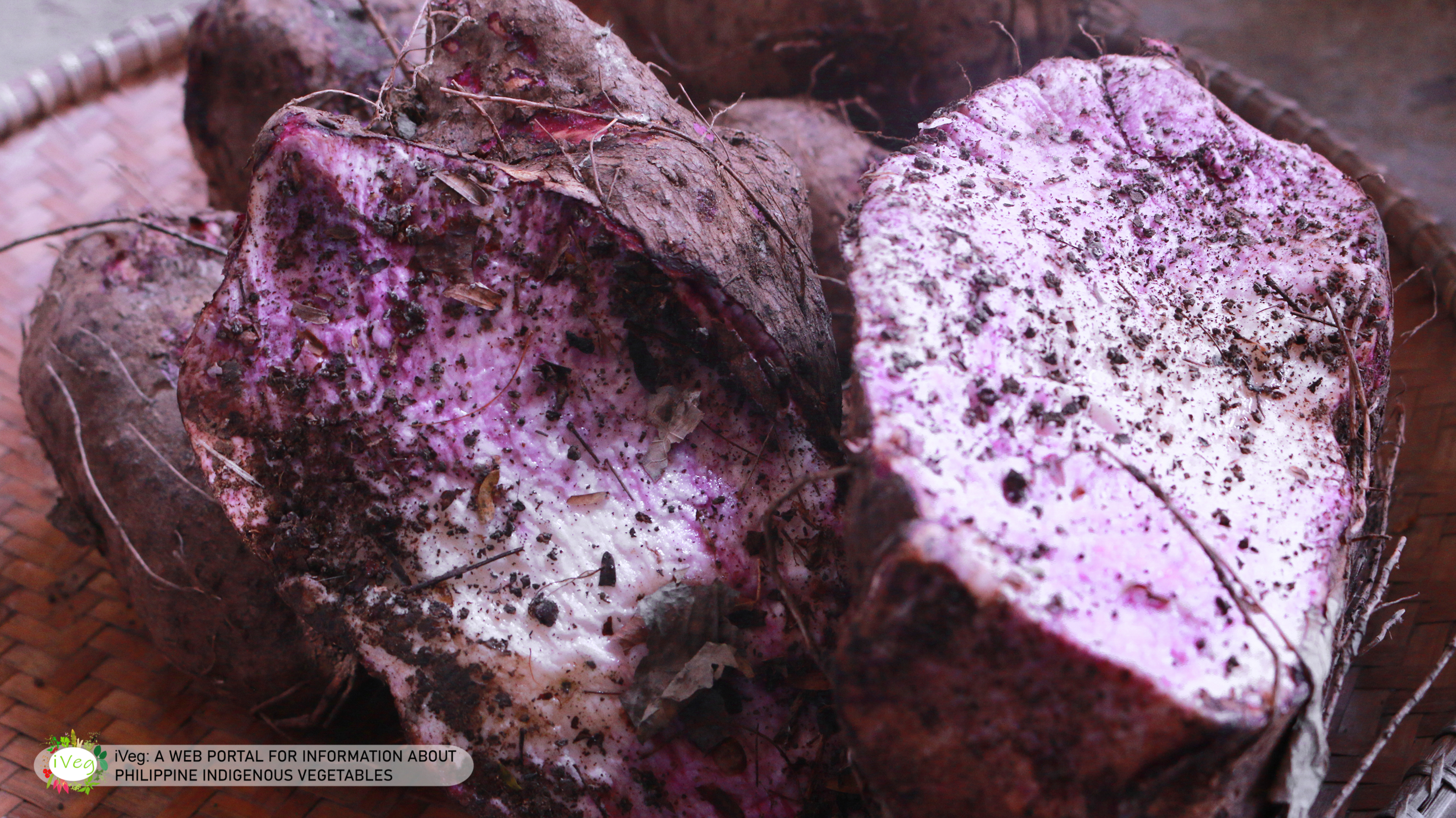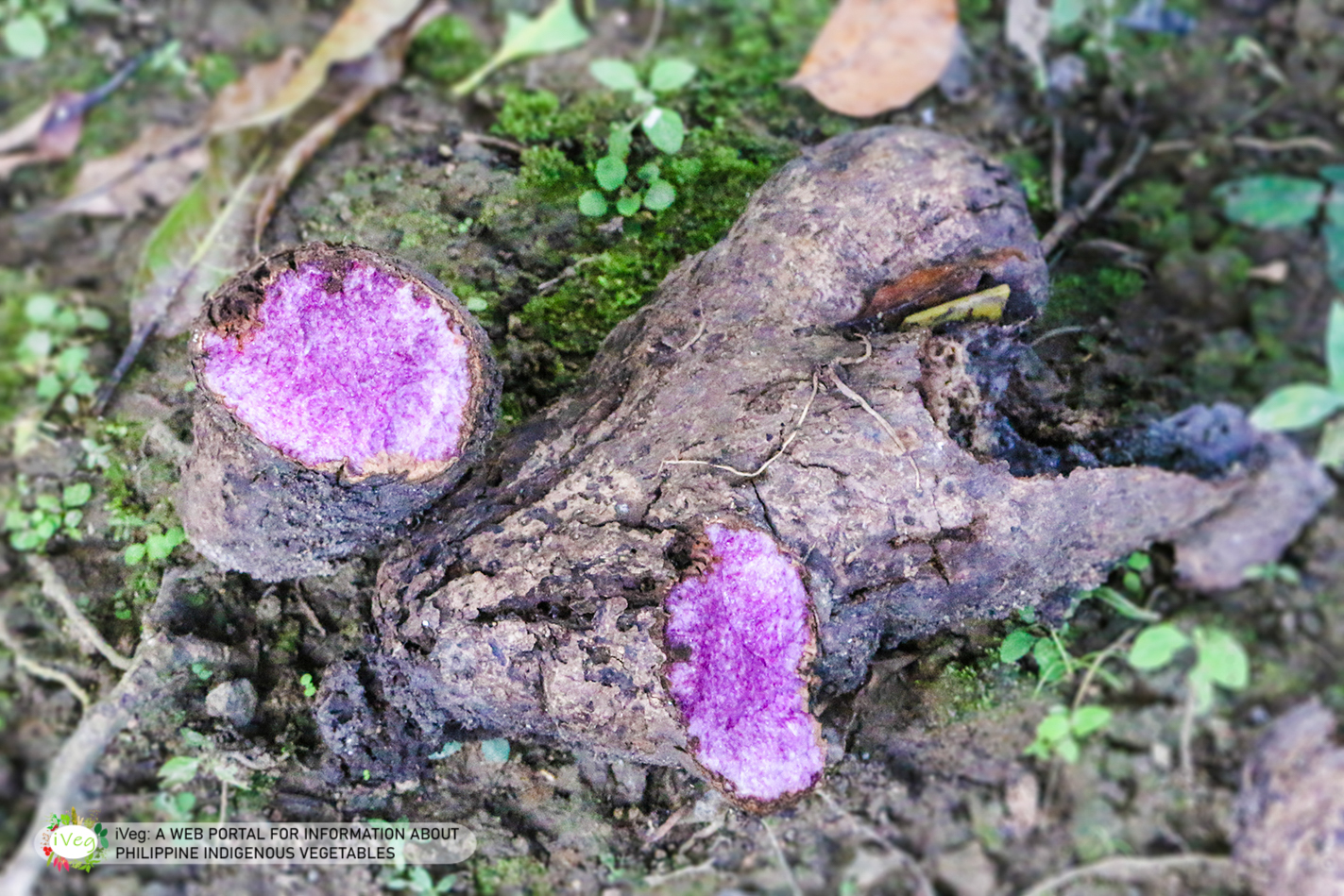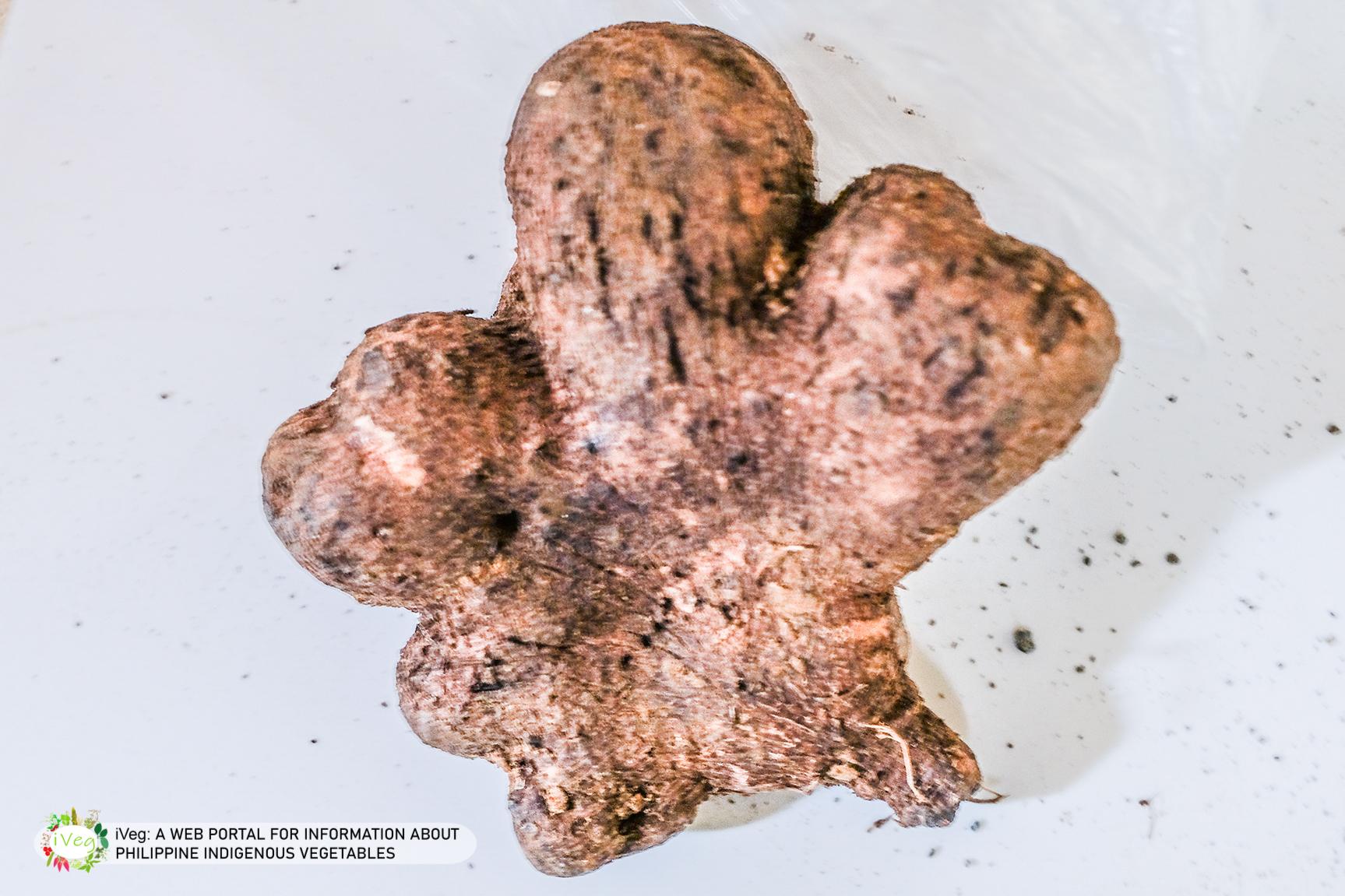Ube/Purple yam
Dioscorea alata L.
Family:
Dioscoreaceae
Synonyms:
Dioscorea alata var. globosa,
Dioscorea alata var. purpurea,
Dioscorea alata var. tarri,
Dioscorea alata var. vera,
Dioscorea atropurpurea
Philippine local names:
English Name: Greater, water, white, or winged yam
Botanical Description
Vigorously twining herbaceous vine, from massive underground
tuber. Stems to 10 m (30 ft) or more in length, freely branching above; internodes square
in cross section, with corners compressed into “wings,” these often red-purple tinged.
Aerial tubers (bulbils) formed in leaf axils (not as freely as in D. bulbifera), elongate, to
10 cm (4 in) x 3 cm (1.2 in), with rough, bumpy surfaces. Leaves long petioled, opposite
(often with only 1 leaf persistent); blades to 20 cm (8 in) or more long, narrowly heart
shaped, with basal lobes often angular. Flowers small, occasional, male and female arising
from leaf axils on separate plants (i.e., a dioecious species), male flowers in panicles to 30
cm (1 ft) long, female flowers in smaller spikes. Fruit a 3-parted capsule; seeds winged.
NOTE: May be confused with D. bulbifera L., which has small or absent underground
tubers, more numerous aerial tubers, and alternate leaves (see next pages). Native wild
yams, D. floridana Bartl. and D. quarternata (Walt.) Gmel., infrequent in hammocks and
floodplains of north and west Florida, never forming aerial tubers, leaf blades rarely to 15
cm (6 in) long.
=https://www.fleppc.org/ID_book/Dioscorea%20alata.pdf
Dioscorea alata is slender creeping vine reaching a length of several meters. The leaf-stalk slightly purple at both points of attachment. Tubers are usually bright lavender in color, occasionally white. Root is tumorous, often with small axillary tubers.
=http://www.stuartxchange.org/Ubi
tuber. Stems to 10 m (30 ft) or more in length, freely branching above; internodes square
in cross section, with corners compressed into “wings,” these often red-purple tinged.
Aerial tubers (bulbils) formed in leaf axils (not as freely as in D. bulbifera), elongate, to
10 cm (4 in) x 3 cm (1.2 in), with rough, bumpy surfaces. Leaves long petioled, opposite
(often with only 1 leaf persistent); blades to 20 cm (8 in) or more long, narrowly heart
shaped, with basal lobes often angular. Flowers small, occasional, male and female arising
from leaf axils on separate plants (i.e., a dioecious species), male flowers in panicles to 30
cm (1 ft) long, female flowers in smaller spikes. Fruit a 3-parted capsule; seeds winged.
NOTE: May be confused with D. bulbifera L., which has small or absent underground
tubers, more numerous aerial tubers, and alternate leaves (see next pages). Native wild
yams, D. floridana Bartl. and D. quarternata (Walt.) Gmel., infrequent in hammocks and
floodplains of north and west Florida, never forming aerial tubers, leaf blades rarely to 15
cm (6 in) long.
=https://www.fleppc.org/ID_book/Dioscorea%20alata.pdf
Dioscorea alata is slender creeping vine reaching a length of several meters. The leaf-stalk slightly purple at both points of attachment. Tubers are usually bright lavender in color, occasionally white. Root is tumorous, often with small axillary tubers.
=http://www.stuartxchange.org/Ubi
Agroclimatic/Edaphic adaption/Ecology
Major cultivated species
and most widely distributed throughout the tropics.
=Understanding the genetic diversity and population structure of yam (Dioscorea
alata L.) using microsatellite markers
and most widely distributed throughout the tropics.
=Understanding the genetic diversity and population structure of yam (Dioscorea
alata L.) using microsatellite markers
Geographical Distribution
Distribution: Cultivated throughout the tropics for its edible underground tuber, and unknown in the wild state (Coursey 1967, Purseglove 1975). In Florida, herbarium records now reported for naturalized populations in 7 counties: Escambia, Gadsden, Leon, Levy, Charlotte, Lee, and Dade (Wunderlin et al. 1996).
=https://www.fleppc.org/ID_book/Dioscorea%20alata.pdf
- Throughout the Philippines in thickets at low and medium altitudes.
- Cultivated.
=http://www.stuartxchange.org/Ubi
=https://www.fleppc.org/ID_book/Dioscorea%20alata.pdf
- Throughout the Philippines in thickets at low and medium altitudes.
- Cultivated.
=http://www.stuartxchange.org/Ubi
Propagation
Life History: Normally grows for 8-10 months, then goes dormant for 3-4 months, with
aerial stems dying back during dormancy (Martin and Rhodes 1977). Grown commercially
as far north as southern Japan, a latitude similar to south Georgia’s (Okagami
1986). Said to survive winters in France if planted deep enough (Coursey 1967). Fertile
seeds rarely produced; spread by aerial tubers and fragments of underground tuber
(Coursey 1967).
=https://www.fleppc.org/ID_book/Dioscorea%20alata.pdf
aerial stems dying back during dormancy (Martin and Rhodes 1977). Grown commercially
as far north as southern Japan, a latitude similar to south Georgia’s (Okagami
1986). Said to survive winters in France if planted deep enough (Coursey 1967). Fertile
seeds rarely produced; spread by aerial tubers and fragments of underground tuber
(Coursey 1967).
=https://www.fleppc.org/ID_book/Dioscorea%20alata.pdf
Part utilized as vegetables
Tubers
Uses
Industry
The edible portion is chiefly rich incarbohydrate along with good amount of proteinand minerals (Mantell and Hugo, 1989). They also playan important role in tropical food economy, especiallyof South Africa where it is taken as a staple food witha fairly per capita consumption of 0.5 to 1Kg(Ammirato, 1976). In India, tubers of D. alata areconsumed mostly in Southern and North easternstates, and their importance is greater than potato insome areas.
=https://www.researchgate.net/publication/268180518_Micropropagation_of_Greater_Yam_Dioscorea_alata_L_cv_Hatikhujia_Through_Vine_NodesMedicinal
The plant has been found to rich in medicinal properties such as anticancer, antidibetic, antimicrobial activity. The plant tuber have been found to rich in nutrients and antinutrients such as crude protein 2.81(%), carbohydrates 6.80(%), crude fibre 4.01(%), crude fat 0.81(%) and antinutrients alkaloids 0.51(%), flavonoids 1.32(%), saponins 2.56(%) and tannins 0.66(%) respectively. This analysis revealed that the plants contained potent medicinal properties as compared to another medicinal plant.
=https://www.researchgate.net/publication/259578606_Nutritional_activity_Dioscorea_alata_pdf
Correct Citation
Documentation of Indigenous Vegetables (2020) Retrieved from www.iveg.com.
See references:
https://www.fleppc.org/ID_book/Dioscorea%20alata.pdfUnderstanding the genetic diversity and population structure of yam (Dioscorea alata L.) using microsatellite markers
https://www.researchgate.net/publication/259578606_Nutritional_activity_Dioscorea_alata_pdf
http://www.stuartxchange.org/Ubi
https://www.researchgate.net/publication/268180518_Micropropagation_of_Greater_Yam_Dioscorea_alata_L_cv_Hatikhujia_Through_Vine_Nodes
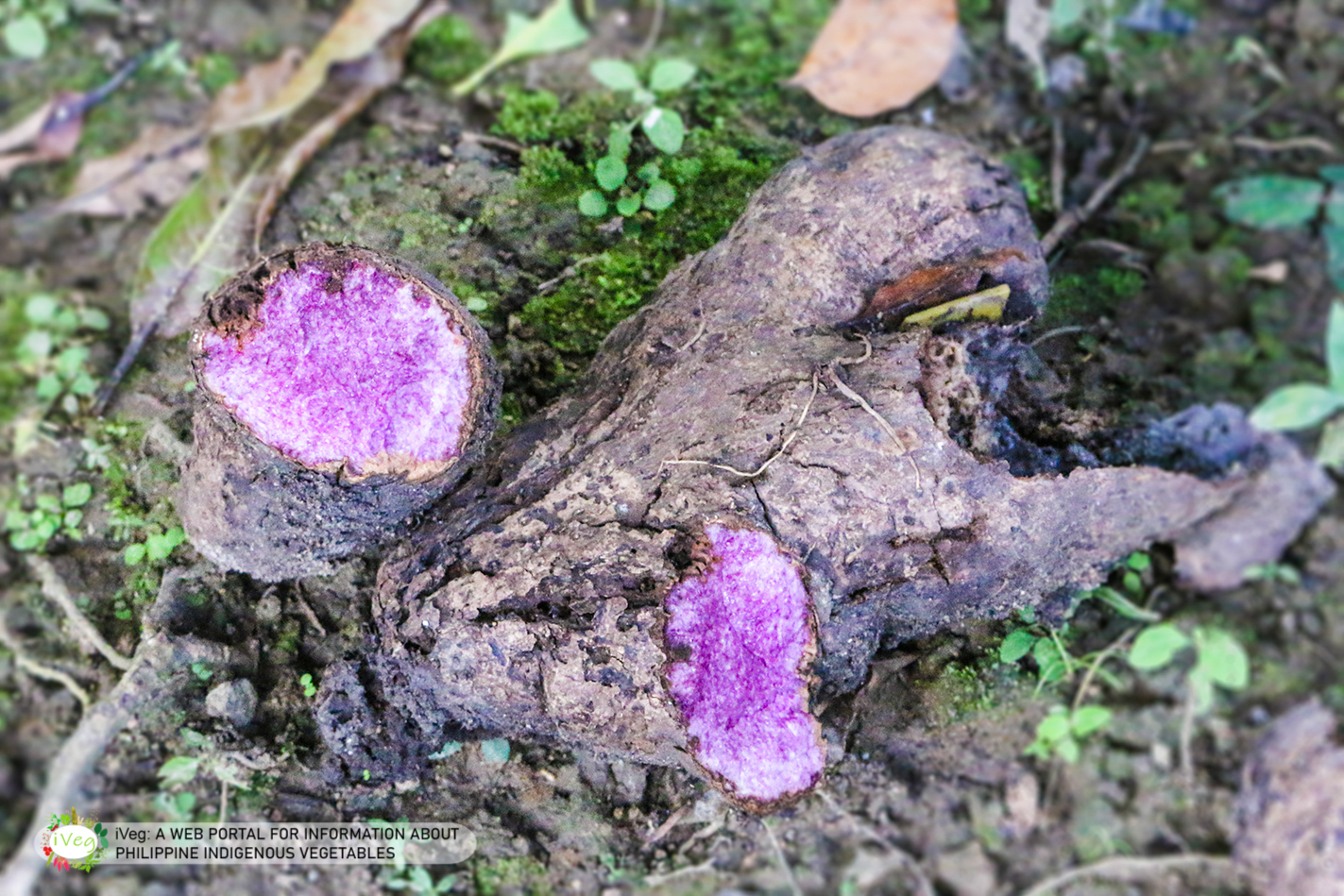















Properties
Food Composition per 100g Edible Portion | Unit | Yam, purple | Yam, purple, boiled | Yam, purple, pudding | |||
|---|---|---|---|---|---|---|---|
| Water
Energy, calculated Energy, calculated Protein Total Fat Carbohydrate, total Carbohydrate, available Ash, total |
g
kcal kJ g g g g g |
74.9 7 408 1.7 0.2 22.2 18.8 1 |
80.4 76 320 0.7 0.1 18.2 15.6 0.6 |
53.5 187 783 1.2 0.8 43.8 42.1 0.7 |
courtesy of Food and Nutrition Research Institute Department of Science and Technology

